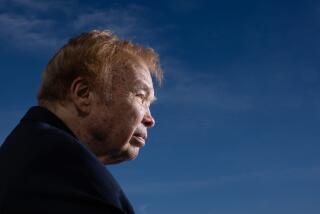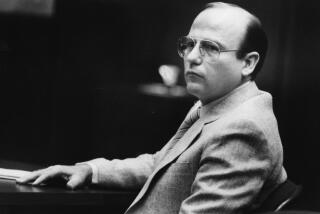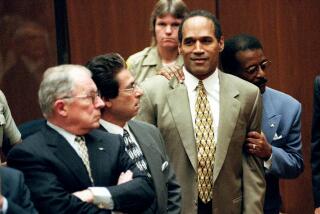Justice and friendship prevail
First Of Two Parts â The man, a thin and gray-haired federal judge, walked nervously up and down the streets of skid row, past drug dealers, pimps and thugs, past rows of men lying like glass-eyed zombies against concrete walls.
âExcuse me,â he said, pulling out a photograph, âhave you seen this man?â He was met by blank faces or angry stares. And, always, one word: âNo.â
He couldnât give up. Down more streets and through urine-soaked alleys. He was the only white person he could see.
To Judge Spencer Letts, then 72, this distinction did not matter. What mattered was that Michael Banyard, an ex-con who had lived much of his adult life in prison, could be in trouble again.
Letts told himself that if he could just find him, Banyard would not run -- even if he were in a drug-induced stupor. Instead, he would peer at the judge through his dreadlocks, smile his sheepish smile and the two would walk a few blocks to an entirely different world -- the judgeâs chambers inside the U.S. Central District Courthouse. There they would sit, as they so often had, and Letts would try to convince his friend that the troubled man on skid row was not the real Banyard. Not the man the judge believed in.
John Spencer Letts was born in St. Louis in 1934, the privileged son of a vice president at Prudential Insurance. He went to Yale, Harvard Law and, in the early 1960s, to a powerhouse litigation firm in Houston. âAs a lawyer,â he said, âa lot of times I would fail. But then one case would come up that everyone else was struggling with and I guess I would just look at it in a way that was different. I would find a solution others would look past. And that became my reputation: out of the box.â
FOR THE RECORD: A previous version of the photo caption above said Letts has mentored several men he has put in jail, including Banyard. Banyard was sentenced to prison by another judge; Letts handled his appeal.
He took that reputation to Los Angeles, where in 1966 he became vice president at the budding high-tech conglomerate Teledyne. As the companyâs legal chief, he burrowed deeply into his work, overseeing acquisitions. He provided a life of comfort for his wife, two sons and daughter. There were country clubs and boarding schools, tennis lessons and summer vacations at a home on a Michigan lake that had been in his family for generations.
He was a Republican but mostly steered clear of politics. He was well-connected, however, with lawyers and businessmen who had ties with the White House, and that paid off. President Reagan nominated Letts for an opening on the District Court.
Confirmed in 1986, Letts proved unusual from the start. At the courthouse, he spoke softly, tended to mumble, was prone to nervous laughter and would launch into asides on such subjects as the nature of time, the age of reason and the essential goodness of man. After long periods of meandering, heâd get back to the legal point and nail it.
Some lawyers hated going to his court. He wasnât just hard to understand, his views and rulings were unpredictable. Others saw him as a refreshing maverick who plowed through all manner of ideas before settling on a reasonable course. âHeâs a truth teller, unafraid to follow uncommon lines of thought as far as he can go,â said veteran defense attorney Michael Proctor. âAnd that makes a lot of people uncomfortable.â
The federal judiciary is stacked with former state judges and prosecutors who have spent years in courtrooms. Because he had always preferred to settle cases as a lawyer, Letts had rarely been in court. At first, there were basic procedures he didnât know. Moreover, he had no experience with many of the kinds of cases he would oversee, which came from a world of gangs, drugs and guns.
âI was terrified, absolutely terrified,â he said of his early days as a judge. âStreet crime? What did I know about that?â
Meanwhile, he also was confronted with a new federal law that mandated long sentences for the sale or possession of crack, giving judges no leeway.
Unable to consider the context of cases, he grew indignant at being required to sentence wrongdoers to decade-long prison terms when he often felt they deserved far less. His anger intensified when he saw that almost every defendant coming into his courtroom was black, even as statistics showed that most drug users were white.
He was struck by how smart many of them seemed, how driven. Born into different circumstances -- into his circumstances -- some also might have become vice presidents at Teledyne, he figured.
âI began to see that it is all too easy for a judge to just put a C for convicted on a guyâs forehead and then to walk away like the guy is, and always will be, nothing,â he said. âIt hit me -- I am going to try my best, from then on, to extend myself, see their humanity and let them see mine.â
He fought hard against mandatory sentences, calling them discriminatory and even unconstitutional, disparaging them in opinions that circulated in legal circles and earned him the ire of federal prosecutors. Required to give a 10-year prison term to a man with no criminal record who pleaded guilty to mailing a package containing crack, Letts asked for a presidential pardon. The Reagan administration turned him down.
His fight became personal. Sometimes, Letts would drive to the toughest parts of South Los Angeles, to housing projects and gang-ridden apartments, where he would visit the parents, siblings and cousins of those he had put in prison. He would sit in their living rooms, ask about their lives, tell them he cared and counsel young ones not to run with the tough crowds. When the men he sentenced got out of prison, he would ask a favor: that they keep him apprised of their progress.
âMy guys,â he came to call them, noting that one became a basketball coach, another a construction worker and another a music producer. âMy crack guys.â
As proud as he was of all of them, none affected him the way Banyard did.
Michael Banyard was born in Compton in 1967, the son of a truck driver and a beautician. âWhen I gave birth to Michael he had a 102-degree fever,â said his mother, Obie. âI remember the doctors putting him in an ice bath and I remember how terribly worried I was for my child. That was the start.â
His mother recalled that young Michael was sweet, shy and deeply affected by what happened around him. When he was 5, gang members broke into the familyâs home, rampaging through everything. His mother never forgot the look on her sonâs face when the break-in was discovered: fear, helplessness and anger. They were emotions he could never seem to shake.
His father left the family when Banyard was in grade school. The men he looked up to were gangsters. By 16, he was one of them, a full-fledged member of the Compton Santana Crips who sold crack on the streets. His gang name was Loco Mike.
That was one side of him. The other was the polite, razor-smart, church-going teen who would retreat to his room for hours, hounded by shame for his street life, remembering childhood days when he would fall asleep on his fatherâs chest.
At 17, he turned to the drug he had been selling. It wasnât long before crack owned him. He sold his girlfriendâs jewelry to pay for a high. Then he hocked her Chrysler LeBaron to a stranger. He went to a police station and begged to be arrested because he couldnât stop. The cops told him to go home.
In 1988, he was in a minor car wreck and stole $6 from the other driver. He was arrested and convicted. It was his first time in prison, his first felony. Under California law, his first strike.
When he got out three years later, he fared well for a while, managing his motherâs Inglewood beauty shop. But one night he got high. He fought with his girlfriend and she called the police. He pleaded no contest to assault and was placed on probation. It was his second strike.
By 1994, he had lost every vestige of control over crack. His addiction pushed him onto the forlorn patch of downtown streets that is skid row. He was arrested for a string of petty crimes, but mostly the cases were dismissed. When they werenât, he got probation or a few weeks in jail. Then he was back on the streets.
He no longer called his family, even his mother. He smelled of urine, slept on sidewalks and underneath cars. There were times when his clothing was stolen, so he fashioned pants out of large plastic garbage bags, tied at his waist.
One day, he made his way to a freeway overpass and looked down at the cars. He was ready to jump. But at the last moment he thought of his mother and stumbled away.
On Sept. 4, 1996, a stranger approached with crack. Suddenly, cops swooped in. They would later testify that they saw drugs drop to the ground as they approached, drugs Banyard had just bought. It was less than a gram of crack, barely enough to fit under a fingernail. That didnât matter. He was convicted and it was his third felony.
Californiaâs three-strikes law mandated that he be sent to prison for at least 25 years. At the end of that time, his release would be subject to approval from a parole board. He could die behind bars.
In prison, Banyard was free from drugs. His mind cleared and his anger softened. He gained a new sense of spirituality and spent almost all his time in the prison law library, preparing appeals. A state court reviewed his case and turned him down. A federal magistrate said his claims lacked merit. The attorney general said he should remain in prison.
By 2002, he was down to one last appeal -- to the U.S. District Court, where his case went to Letts. The judge was approaching 70 then, working less and reflecting on his life. He thought often of his father -- a steady, stealthy drinker late in life -- and of a cousin who became a fervent member of Alcoholics Anonymous. He had empathy for their struggle. He had his own dark bouts with depression and sometimes talked openly about them in court. He understood how it felt to battle despair.
It was against this backdrop that he took Banyardâs case.
âI couldnât put my finger on it but it just rubbed me the wrong way,â he said. âTwenty-five years, no guarantee of ever leaving, for that amount of cocaine? Something was wrong. Very wrong.â
He researched every aspect of the case, work that took 2 1/2 years. Banyardâs appeals were well crafted but needed sharpening. The judge took the unusual step of hiring lawyers to help him.
On Oct. 4, 2004, Letts issued a 32-page ruling. Banyard was in his cell at the San Luis Obispo Menâs Colony when he received the manila envelope. As he opened it, his hands began to tremble. He was so nervous, his cellmate had to read the ruling to him.
Letts wrote that the $6 robbery was âoutside the heartland of serious felonies that normally constitute . . . strikes under the Three Strikes Law.â
He said Banyardâs pre-appeal lawyers had let their client down and dismissed as irrelevant Banyardâs history of petty crimes and arrests for which he was never prosecuted. He said second-degree murderers, rapists and those guilty of voluntary manslaughter received lighter sentences than Banyard had.
Most important, he ruled that in Banyardâs second strike, there had been a serious mistake: The state court recorded it as an assault with a gun, but Banyard had actually pleaded no contest to simple assault. âThat,â Letts wrote, âdid not constitute a felony for purposes of the Three Strikes Law.â
âBanyardâs sentence,â the judge wrote, âis grossly disproportionate to his offense and constitutes cruel and unusual punishment, in violation of the 8th Amendment.â
Michael Banyard was freed.
Next: Friendship grows.
More to Read
Sign up for Essential California
The most important California stories and recommendations in your inbox every morning.
You may occasionally receive promotional content from the Los Angeles Times.











